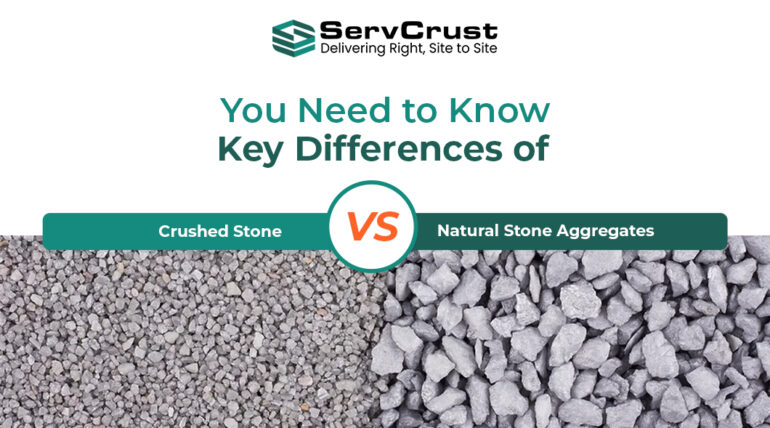
When it comes to choosing the right materials for construction or landscaping projects, understanding the differences between crushed stone and natural stone aggregates is crucial. Although these two options may appear similar at first glance, their unique characteristics can significantly influence the overall durability, aesthetics, and cost-effectiveness of your project. Therefore, making an informed choice becomes essential to achieve the desired results.
Crushed Stone Aggregate forms when machines crush larger rocks. This mechanical process ensures consistent sizes and shapes, making the material reliable for a wide range of construction and landscaping applications. On the other hand, Natural Stone Aggregate is harvested directly from quarries and features unique textures and colors that enhance visual appeal. Whether you’re a builder, homeowner, or contractor, clearly understanding these variations will help you confidently choose the right aggregate to match your specific design goals and structural needs. Let’s explore how these two types of stone aggregates compare and which one is ideal for your construction needs.
What is a Crushed Stone Aggregate?
Manufacturers use heavy machinery to crush rocks like limestone, granite, and trap rock into smaller, angular pieces, producing crushed stone aggregates. These materials serve as essential components in a wide range of construction and landscaping applications.
Suppliers classify crushed stone into different grades based on size from fine stone dust to larger coarse stones. This grading system allows builders to choose the most suitable type for each project requirement.
Applications of Crushed Stone
- Road Construction:
Used as a base layer in highways, rural roads, and parking areas for its stability and strength. - Concrete and Asphalt Mixes:
Commonly used as an aggregate in concrete and asphalt to improve binding and durability. - Foundations and Base Layers:
Provides a strong, interlocking base for buildings, pavements, and paver blocks. - Landscaping Projects:
Ideal for pathways, patios, and driveways thanks to its angular shape that compacts well.
What is Natural Stone?
Workers extract natural stone aggregates directly from riverbeds, pits, and rock deposits without any mechanical crushing. These stones form over millions of years through natural geological processes, resulting in distinct textures, colors, and patterns. Common types of natural stone aggregates include river rock, pea gravel, and decomposed granite, each offering distinct visual and functional characteristics.
Over time, water and weather naturally shape these stones into smooth, rounded particles. This erosion process gives natural stone aggregates their polished appearance, making them highly desirable for decorative and architectural use.
Applications of Natural Stone Aggregates
- Garden & Landscape Design:
Popular in rock gardens, borders, pathways, and around water features for their smooth, organic appearance. - Decorative Pathways & Driveways:
Pea gravel and river rock offer a clean, aesthetic finish for outdoor spaces. - Outdoor Living Spaces:
Perfect for patios, retaining walls, and sitting areas due to their durability and natural charm. - Drainage & Erosion Control:
Smooth stones allow water to flow easily, helping manage runoff and protect soil.
Crushed Stone vs Natural Stone: Key Differences
| Feature | Crushed Stone | Natural Stone |
| Source & Processing | Made by mechanically crushing rocks like granite or limestone | Formed naturally in riverbeds or quarries, shaped by erosion |
| Texture & Shape | Angular and sharp-edged, which improves binding | Smooth and rounded, which reduces bonding strength |
| Binding Performance | Binds tightly with cement due to rough texture | Provides weaker bonding, not ideal for structural concrete |
| Price Factors | Generally more affordable due to widespread availability | Often costlier, especially for decorative or specialty uses |
| Best Use Cases | Suitable for structural works like roads, foundations, concrete | Ideal for aesthetic or decorative landscaping projects |
| Sourcing Aggregates | Easily sourced from local quarries or suppliers at lower cost | Limited availability in some areas, often sourced from rivers |
Which Aggregate Is Best for Concrete Strength?
When strength is a priority, crushed stone is the clear winner. Its sharp edges and better binding ability give concrete more load-bearing capacity. Natural stone may look better, but it compromises on performance, especially for structural work.
Cost and Sourcing Considerations
Price Factors
The cost of stone aggregates can vary based on the type of material, size, location, and method of transport. Crushed stone is generally priced per ton and is cheaper than most decorative natural stones.
Sourcing Aggregates Locally vs Online
Many builders prefer sourcing from aggregate suppliers near them to save on transport costs. However, with online platforms like Servcrust, it’s now easier than ever to buy construction aggregates online at competitive prices with guaranteed quality.
Buying Aggregates Online: What to Look For
Choose a Reliable Online Supplier
Always check if the supplier is certified, reliable, and offers support after delivery. Servcrust platform is a trusted for transparent pricing, quick service, and right quality assurance.
Delivery & Logistics
Timely delivery matters in construction. Servcrust delivers crushed stone aggregates within 24 hours across Andhra Pradesh and Telangana, ensuring you get the right quantity at the best price, without delays.
Conclusion
Choosing between crushed stone and natural stone aggregates depends entirely on your project’s needs. If you need high strength, better binding, and cost-efficiency, crushed stone is the ideal choice. If appearance and aesthetics matter more, natural stone could be your go-to.
For the best deals, trusted quality, and reliable delivery, Contact Servcrust, your one-stop platform to buy construction aggregates online.
